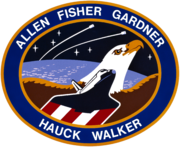 Dale A. Gardner poses in front of a camera with a "For Sale" sign in his hand, jokingly referring to the two broken satellites (Palapa B2 and Westar 6) the crew was sent out on EVA to pick up and return to Earth. | |
| Names | Space Transportation System-14 |
|---|---|
| Mission type | Communications satellites deployment Communications satellites retrieval |
| Operator | NASA |
| COSPAR ID | 1984-113A |
| SATCAT no. | 15382 |
| Mission duration | 7 days, 23 hours, 44 minutes, 56 seconds |
| Distance travelled | 5,293,786 km (3,289,406 mi) |
| Orbits completed | 127 |
| Spacecraft properties | |
| Spacecraft | Space Shuttle Discovery |
| Launch mass | 119,442 kg (263,325 lb) |
| Landing mass | 94,123 kg (207,506 lb) |
| Payload mass | 17,375 kg (38,305 lb) |
| Crew | |
| Crew size | 5 |
| Members | |
| EVAs | 2 |
| EVA duration |
|
| Start of mission | |
| Launch date | November 8, 1984, 12:15:00 UTC (7:15 am EST) |
| Launch site | Kennedy, LC-39A |
| Contractor | Rockwell International |
| End of mission | |
| Landing date | November 16, 1984, 11:59:56 UTC (6:59:56 am EST) |
| Landing site | Kennedy, SLF Runway 15 |
| Orbital parameters | |
| Reference system | Geocentric orbit[1] |
| Regime | Low Earth orbit |
| Perigee altitude | 332 km (206 mi) |
| Apogee altitude | 354 km (220 mi) |
| Inclination | 28.45° |
| Period | 90.40 minutes |
| Instruments | |
| Diffused Mixing of Organic Solutions (DMOS) | |
 STS-51-A mission patch  From left: Gardner, Walker, Fisher, Hauck and Allen | |
STS-51-A (formerly STS-19) was the 14th flight of NASA's Space Shuttle program, and the second flight of Space Shuttle Discovery. The mission launched from Kennedy Space Center on November 8, 1984, and landed just under eight days later on November 16, 1984.
STS-51-A marked the first time a shuttle deployed two communications satellites, and retrieved from orbit two other communications satellites. The Canadian Anik D2 and Syncom IV-1 satellites were both successfully deployed by the crew of Discovery. Palapa B2 and Westar 6, meanwhile, had been deployed during the STS-41-B mission earlier in the year, but had been placed into improper orbits due to the malfunctioning of their kick motors; they were both safely recovered and returned to Earth during STS-51-A.